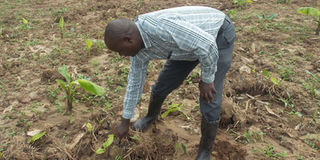How survival pushed farmers to fight banana disease

What you need to know:
- One approach to boost farmers for BBW control and general banana management to improve yields was involving farmers in competitions.
- To promote horizontal interactions among farmers, exchange visits to other banana growing areas were organised.
For farmers in Bushenyi District, knowing that their wellbeing was at stake was all it took to manage the deadly banana wilt disease, writes Zadock Amanyisa.
In 2005, districts in southwestern Ugandan food basket and banana growing area realised they were losing banana plantations to Banana Bacterial Wilt (BBW).
In greater Bushenyi, comprising of Sheema, Bushenyi, Mitooma, Rubirizi and Buhweju districts, the disease threatened several households that depend on bananas both for food and income.
Eldard Kakwenzire, a banana farmer, says the disease spread quickly and as a coping mechanism, they resorted to heating farm equipment before use. But this was not effective until expert help was sought.
The help
Bioversity International, an international research institute and National Agricultural Research Organisation (Naro) developed control tools that were tested. After confirming the efficiency of the tools to fight the disease, they were disseminated to the agricultural technical officers who used them in the affected areas.
Measures included avoiding the introduction of the disease through infected planting material, breaking the male bud using a forked wooden stick, clearing infected plants to reduce inoculums through: uprooting infected mats, removing single-disease stems, or using herbicides to kill infected plants, and cleaning (sterilising) garden tools using fire or bactericides such as sodium hypochlorite.
To ensure monitoring of progress, farmers were trained in data recording for disease incidence and yield.
One approach to boost farmers for BBW control and general banana management to improve yields was involving farmers in competitions.
The project distributed clean banana germplasm to farmers to rehabilitate fields destroyed by BBW or to establish new ones. Training of group leaders on how to use mobile phones to access BBW extension information, weather and price information was conducted and this was supplemented by connecting all the site farmers to the FARMIS platform for easy access of information, including BBW management. To promote horizontal interactions among farmers, exchange visits to other banana growing areas were organised. Amon Natwebembera, the Bushenyi District agricultural officer, says the Ministry of Agriculture has developed bylaws for the banana bacterial wilt control for local governments.
which Bushenyi district embraced.
The initiative was popularised in the local council ones which forwarded it to the sub-counties and then to the district council for ratification.
Challenges
In the course of the BBW battle, the district faced some challenges. In some areas, the banana plantations were owned by elderly people and orphaned children who had no capacity to monitor and cut the diseased plants.
Some of our farmers have planted eucalyptus trees amidst banana plantations which have created competition for soil nutrients resulting into drying of our crops.
The soils have generally lost their original fertility and it has led to drastic reduction in harvests thus poor yields. These soils require organic manure, even when we have fought the disease (BBW), to increase productivity and maximize production.
Success
In 2012, banana production had reduced significantly due to increased intensive control, within six months, there was significant growth in the business.
The district has established a banana demonstration farm to enable farmers get practical skills in the fight against BBW, which is among other interventions employed to promote the banana growth.




